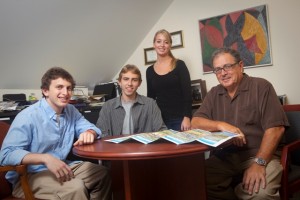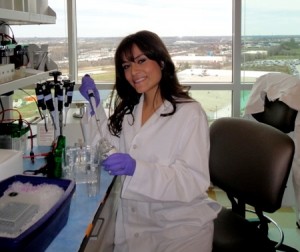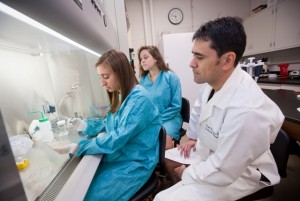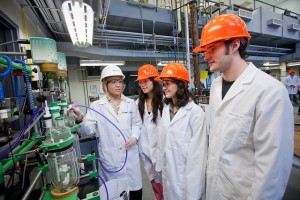At Lafayette, students in virtually any major needn’t look far to find the opportunity to work one-on-one with faculty, who are substantial contributors in their respective fields, on high-level research. Students routinely work on projects that result in conference presentations, peer-reviewed journal publications, national scholarships and fellowships, and acceptance into some of the country’s top graduate programs.
“Undergraduate research is an integral part of this community,” says John Meier, director of research services. “It is a natural outgrowth of having excellent students on campus who interact on a daily basis with faculty who are producing very interesting scholarly work. This sort of student-faculty interaction isn’t just valued, it is a deeply embedded part of our identity.”
Meier estimates that approximately 140 students each summer and over 100 students each academic year serve as EXCEL Scholars, a unique program in which students earn a stipend while working collaboratively with faculty on research projects that expand the boundaries of knowledge.

Ross Tilchin ’11, Tyler Bamford ’12, Hannah Finegold ’11, and Professor Donald L. Miller
Through EXCEL, Tyler Bamford ’12 (Souderton, Pa.), Hannah Finegold ’11 (Syosset, N.Y.), and Ross Tilchin ’11 (Bethesda, Md.) worked with Donald L. Miller, John Henry MacCracken Professor of History and an award-winning author and expert on WWII, on his latest book project, Supreme City: New York City 1927.
For his work with Miller and other research he has performed, Bamford has received the prestigious Beinecke Scholarship which will provide him with $34,000 towards a graduate school in the arts, humanities, or social sciences.
“I turned down other schools with large history departments,” says Bamford, a history major who plans to become a history professor. “Here, I knew I would be able to work directly with professors who take a vested interest in my personal growth and success. Being a paid research assistant has given me a taste of the other side of being an academic outside the classroom.”
Some students take a more self-directed approach by choosing a topic that interests them with faculty advisers offering guidance through the independent study and honors programs. Students usually complete an independent study for credit toward their major in one semester. An average of 63 students each year graduate with honors after successfully completing a thesis. Much like graduate school, a student must defend the thesis before a faculty committee in order to earn the honors citation at graduation.
American studies major Sarah Shaffer ’11 (Annandale, N.J.) has presented her honors thesis at the 81st annual meeting of the Eastern Sociological Society and received an Outstanding Achievement Award for her research presentation at the 17th annual Undergraduate Conference in Women’s Studies held by the Lehigh Valley Association of Independent Colleges. Her work explores the genre of self-help business books for women and how although they are meant to help “level the playing field,” the stereotypes presented in this genre actually help to reinforce traditional gendered business norms.
Shaffer’s thesis adviser is Caroline Lee, assistant professor of anthropology and sociology. The two have worked very closely together as Shaffer has also taken numerous classes and performed EXCEL research with Lee.
“It has been a pleasure to watch Sarah’s research skills develop over the last few years, first in her coursework, then as my EXCEL Scholar, and now in her fantastic thesis,” says Lee. “The response she has gotten at conferences has been phenomenal. Her fabulous presentation skills will serve her well in her future career as an entrepreneur.”

Natalia Ibanez ’10
The research neuroscience graduate Natalia Ibanez ’10 performed at Lafayette has led to her pursing an M.D. and receiving a National Institutes of Health (NIH) post-baccalaureate Intramural Research Training Award. At Lafayette, she performed an independent study and EXCEL work under the guidance of Lisa Gabel, assistant professor of psychology. They presented their work at the annual meeting for the International Society for Neuroscience and Faculty for Undergraduate Neuroscience.
“Lafayette enabled me to develop a close relationship with many of my professors,” says Ibanez, “In order to receive this fellowship, the research that I conducted with Dr. Gabel was extremely important–especially the opportunity to present it at the international conference.”
Some of the most valuable experiences and graduate school résumé materials to come out of these research programs are publications in scholarly journals and presentations at national conferences. Each year, Lafayette sends an average of 20-25 students to the National Conference on Undergraduate Research. Additionally, the Academic Research Committee funded 24 conference presentations in the last academic year. Dozens of students co-author publications and present at other conferences each year as well.

Christina Mingora '11 works with Manuel Ospina-Giraldo, assistant professor of biology, on research of late blight disease in potato plants.
Manuel Ospina-Giraldo, assistant professor of biology, has included numerous students in his research on a group of genes in the fungal-like organism Phytophthora infestans, which causes late blight disease in potato plants. He coauthored an article with Megan Chawner ’08, John Griffith ’08, Karolyn Horn ’09, Jessica McWalters ’09, and Lauren Seyer ’08 in the journal Nature. McWalters and Seyer also coauthored an article for Current Genetics. Griffith, Emma Laird ’09, and biology major Christina Mingora ’11 (Bethlehem, Pa.) published in BMC Genomics. Over the next four years, grant funds will allow at least 12 more students to participate in the project.
“I am very proud to see the fruits of my labor published and shared with the scientific community,” says Mingora, who is applying to medical schools. “This is my first publication, and it makes me feel like a very accomplished student and researcher.”

Brian Peacock '12
Research can often serve as a stepping stone to some impressive accolades, including Goldwater and Udall scholarships. For his dedication to environmental research, civil engineering major Brian Peacock ’12 (Haddonfield, N.J.) received a 2011 Udall Scholarship. He is among 80 scholars in the nation selected on the basis of commitment to careers in the environment, leadership potential, and academic achievement. Scholarship recipients receive $5,000 for educational expenses. Earlier this school year, Peacock was also awarded an Environmental Protection Agency-Greater Research Opportunity fellowship, which provides funding for research supplies, tuition assistance, a stipend, and a three-month internship with the EPA this summer.
“The research facilities are outstanding and the small size of the school has enabled me to access all of the facilities with unprecedented ease,” he says. “It has been great to work closely with professors and have the freedom to explore my own ideas.”
See a list of recent Lafayette recipients of national and international scholarships and fellowships for undergraduate and post-graduate study.

Professor Lauren Sefcik Anderson, left, with students
For Lauren Sefcik Anderson ’04, her undergraduate research experience allowed her to come full circle. Under the guidance of James Ferri, associate professor and head of chemical engineering, she secured a National Science Foundation Graduate Research Fellowship, which funded her first three years of graduate school in biomedical engineering. After earning a doctorate at University of Virginia, she returned to Lafayette as an assistant professor of chemical engineering and partnered with her former mentor to secure a $357,106 Major Research Instrumentation grant from the National Science Foundation. The grant is being used to purchase equipment to enhance undergraduate research projects, expand teaching capabilities, and build infrastructure for the department’s new focus on biomolecular engineering.
“The dedication Dr. Ferri showed and the individual attention to my graduate school application were unique and speak volumes to the mentor he is and to the overall dedication of the Lafayette faculty,” says Anderson, who also earned the Faculty Senate Dissertation-Year Fellowship at University of Virginia. “The [NSF] fellowship really made all the difference, as I’m not sure I would have ended up where I am today without it.”
Additional research opportunities at Lafayette include senior design projects for students in the engineering division, the neuroscience program’s Lafayette Alumni Research Network (LEARN), and the math department’s Research Experience for Undergraduates (REU). Through LEARN, neuroscience majors collaborate with alumni on cutting-edge research in the summer and receive a salary for 8 to 10 weeks of full-time work, with travel and housing expenses covered. REU is an intensive, eight-week summer research experience in which undergraduates investigate unsolved problems in mathematics.
At the most recent National Conference on Undergraduate Research last month, Meier saw in the student presenters all of the qualities that research opportunities nurture in young scholars.
“We have grown used to expecting Lafayette students to do an excellent job of presenting their work, and they did that once again,” he says. “But I was most impressed by the research skills and instincts they displayed during the conference when they weren’t presenting. The students were an intellectually curious group, spending hours going to talks and posters, thinking about their peers’ work, and coming up with insights, new directions that could be explored, and spotting difficulties in methodology. Those are not the sort of analytic skills one develops without having this sort of intense, focused experience of working with faculty on research projects.”




